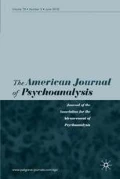Abstract
Psychoanalysis is a transformational process through which meanings become visible and foreclosed identity may be further constituted. Winnicott (1971) marks the crucial developmental function of the relationship that is good enough to tolerate the separateness of the other. The analyst’s ability to “take the transference” enables the patient to locate himself in relation to another mind and being in ways that did not happen sufficiently in childhood. This process requires the signification of personal meanings that can become consensual without subverting one’s own becoming in the process. The dream provides idiosyncratic images that can demarcate conceptual space in ways that can enable the individual to move from the sign to the symbol; from what Kleinians term the symbolic equation, to the symbol proper, the domain of language and consensual meanings. I describe a case in which one young man used his dreams as a way of moving from a universe in which meanings could not be made into one in which he could build meanings in relation to his own experience and ideas.
Similar content being viewed by others
References
Apollon, W., Bergeron, D., & Cantin, L. (2002). After Lacan: Clinical practice and the subject of the unconscious. R. Hughes and K. R. Malone (Eds.) Albany: State University of New York.
Barnes, J. (2011). The sense of an ending. London: Random House.
Bion, W. R. (1963). Elements of psychoanalysis. London: Heinemann.
Bion, W. R. (1967). Second thoughts. London: Heinemann.
Bion, W. R. (1977). Seven servants: Four works. New York: Jason Aronson.
Bion, W. R. (1990). Brazilian lectures: 1973, São Paulo: 1974, Rio de Janeiro/São Paulo. London and New York: Karnac.
Cassirer, E. (1957). The philosophy of symbolic forms: Volume three: The phenomenology of knowledge. (trans: Manheim, R.). London: Oxford University Press.
Charles, M. (2001). Auto-sensuous shapes: Prototypes for creative forms. American Journal of Psychoanalysis, 61, 239–269.
Charles, M. (2002). Patterns: Building blocks of experience. Hillsdale: The Analytic Press.
Charles, M. (2003). Dreamscapes: Portrayals of rectangular space in Doris Lessing’s Memoirs of a Survivor and in dreams. Psychoanalytic Review, 90, 1–22.
Charles, M. (2004). Constructing realities: Transformations through myth and metaphor. Amsterdam and New York: Rodopi.
Charles, M. (2010). When cultures collide: Myth, meaning, and configural space. Modern Psychoanalysis, 34, 26–47.
Charles, M. (2012). Working with trauma: Lessons from Bion and Lacan. Lanham: Jason Aronson.
Charles, M. (2015). Psychoanalysis and literature: The stories we live. Lanham: Rowman & Littlefield.
Eliot, G. (1856). Essays of George Eliot. T. Pinney (Ed.). New York: Columbia University Press.
Ellmann, R. (1959). James Joyce. Oxford: Oxford University Press.
Freud, S. (1900). The interpretation of dreams. Standard edition, Vol. 4–5, (pp. 1–626). London: Hogarth.
Götz, I. L. (1981). On defining creativity. Journal of Aesthetics and Art Criticism, 39, 297–301.
Klein, M. (1975a). The importance of symbol-formation in the development of the ego. In: Love, guilt and reparation and other works, 1921–1945, pp. 219–232. London: Hogarth Press.
Klein, M. (1975b). Notes on some schizoid mechanisms. Envy and gratitude and other works, 1946–1963 (pp. 1–24). London: Hogarth Press.
Lacan, J. (1974–1975). Seminar XII: RSI. (trans: Gallagher, C). Retrieved from: http://www.lacaninireland.com/web/published-works/seminars.
Lacan, J. (1977a). The function and field of speech and language in psychoanalysis. In: Écrits. pp. 292–325 (trans: Sheridan, A.). New York: W. W. Norton.
Lacan, J. (1977b). The subversion of the subject and the dialectic of desire in the Freudian unconscious. In: Écrits, pp. 30–113 (trans: Sheridan, A.). New York: W. W. Norton.
Lacan, J. (1978). The four fundamental concepts of psycho-analysis (trans: Sheridan, A.). New York: W. W. Norton.
Lippmann, P. (2002). Nocturnes: On listening to dreams. New York: Routledge.
Lysaker, P. H., Olesek, K. L., Warman, D. M., Martin, J. M., Salzman, A. K., Nicolò, G., et al. (2011). Metacognition in schizophrenia: Correlates and stability of deficits in theory of mind and self-reflectivity. Psychiatry Research, 190, 18–22.
Main, M., & Hesse, E. (1990). Parent’s unresolved traumatic experiences are related to infant disorganized/disoriented attachment status: Is frightened and/or frightening parental behavior the linking mechanism? In M. Greenberg, D. Cicchetti, & E. M. Cummings (Eds.), Attachment in the preschool years: Theory, research, and intervention (pp. 161–182). Chicago: University of Chicago Press.
Milner, M. (1978). The suppressed madness of sane men. Forty years of exploring psychoanalysis. London and New York: Tavistock.
Molino, A. (2004). Culture, subject, psyche: Dialogues in psychoanalysis and anthropology. London: Whurr.
Obeyesekere, G. (1990). The work of culture: Symbolic transformation in psychoanalysis and anthropology. Chicago and London: The University of Chicago Press.
Ricoeur, P. (1970). Freud and philosophy: An essay on interpretation. New Haven: Yale University Press.
Shaw, G. B. (1921). Back to Methuselah: A metabiological Pentateuch. London: Constable & Company.
Stern, D. A. (1985). The interpersonal world of the infant: A view from psychoanalysis and developmental psychology. London: Karnac.
Winnicott, D. W. (1971). Playing and reality. London: Hogarth Press.
Author information
Authors and Affiliations
Corresponding author
Additional information
Publisher's Note
Springer Nature remains neutral with regard to jurisdictional claims in published maps and institutional affiliations.
Marilyn Charles, Ph. D. ABPP is a psychologist and psychoanalyst at the Austen Riggs Center in Stockbridge, MA, affiliated with Harvard University, University of Monterrey (UDEM), Boston Graduate School of Psychoanalysis, and Chicago Center for Psychoanalysis.
Address correspondence to: Marilyn Charles, Ph.D., 25 Main Street, P.O. Box 962, Stockbridge, MA 01262-0962 USA.
Rights and permissions
About this article
Cite this article
Charles, M. The Dream and the Image: Creative Transformations in Psychoanalytic Space. Am J Psychoanal 79, 174–195 (2019). https://doi.org/10.1057/s11231-019-09194-2
Published:
Issue Date:
DOI: https://doi.org/10.1057/s11231-019-09194-2




